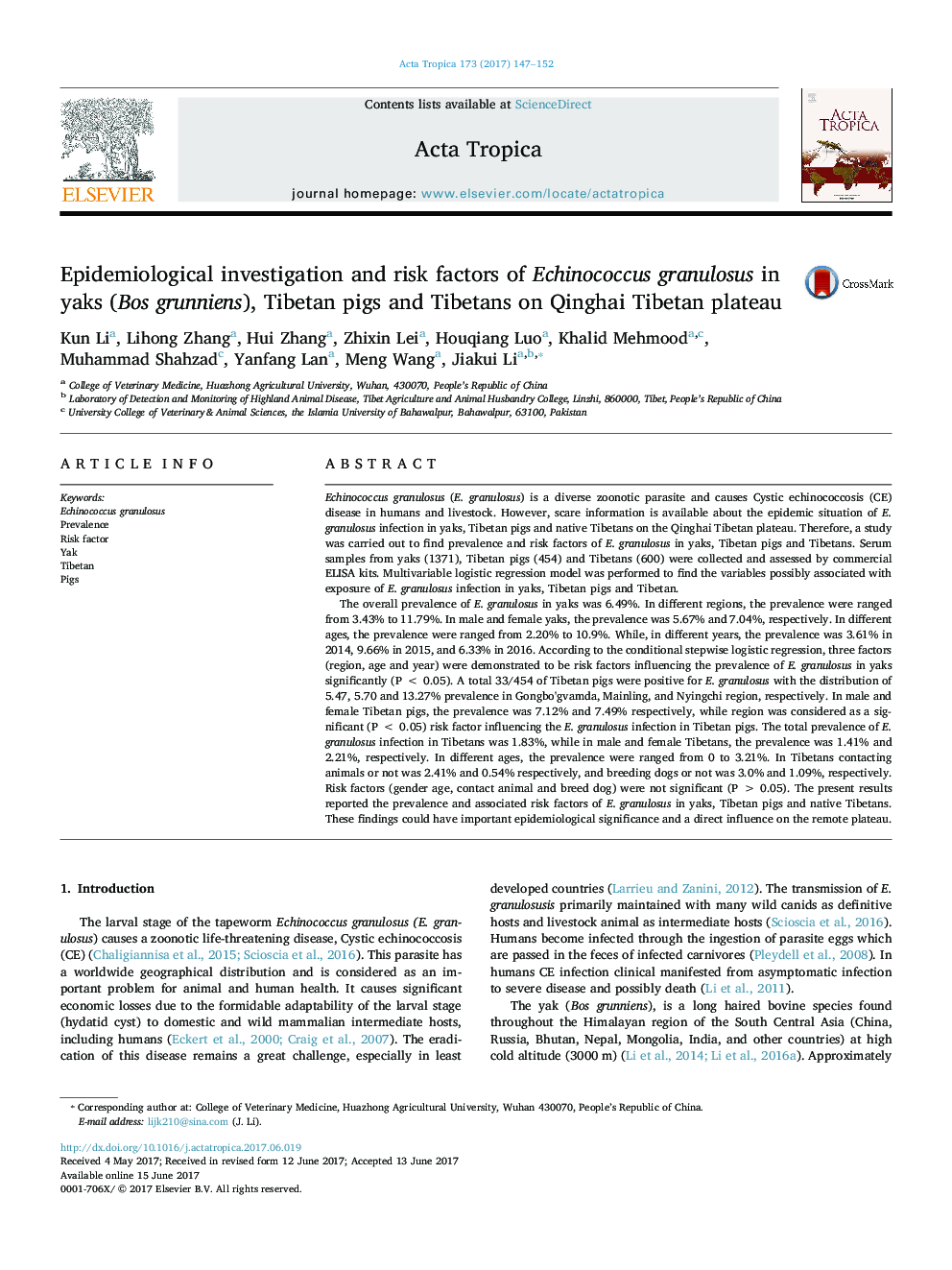| کد مقاله | کد نشریه | سال انتشار | مقاله انگلیسی | نسخه تمام متن |
|---|---|---|---|---|
| 5671090 | 1592751 | 2017 | 6 صفحه PDF | دانلود رایگان |

- Prevalence of E. granulosus and to explore associated risk factors in yaks, pigs and Tibetans
- Prevalence in yaks, pigs and Tibetans was 6.49%, 7.27% and 1.83%, respectively.
- Factors of region, age and year were demonstrated to influence the prevalence of yaks significantly.
- Region was demonstrated to be risk factor influencing the prevalence of Tibetan pigs significantly.
- All risk factors studied were not significant to influence the prevalence of Tibetans.
Echinococcus granulosus (E. granulosus) is a diverse zoonotic parasite and causes Cystic echinococcosis (CE) disease in humans and livestock. However, scare information is available about the epidemic situation of E. granulosus infection in yaks, Tibetan pigs and native Tibetans on the Qinghai Tibetan plateau. Therefore, a study was carried out to find prevalence and risk factors of E. granulosus in yaks, Tibetan pigs and Tibetans. Serum samples from yaks (1371), Tibetan pigs (454) and Tibetans (600) were collected and assessed by commercial ELISA kits. Multivariable logistic regression model was performed to find the variables possibly associated with exposure of E. granulosus infection in yaks, Tibetan pigs and Tibetan.The overall prevalence of E. granulosus in yaks was 6.49%. In different regions, the prevalence were ranged from 3.43% to 11.79%. In male and female yaks, the prevalence was 5.67% and 7.04%, respectively. In different ages, the prevalence were ranged from 2.20% to 10.9%. While, in different years, the prevalence was 3.61% in 2014, 9.66% in 2015, and 6.33% in 2016. According to the conditional stepwise logistic regression, three factors (region, age and year) were demonstrated to be risk factors influencing the prevalence of E. granulosus in yaks significantly (PÂ <Â 0.05). A total 33/454 of Tibetan pigs were positive for E. granulosus with the distribution of 5.47, 5.70 and 13.27% prevalence in Gongbo'gvamda, Mainling, and Nyingchi region, respectively. In male and female Tibetan pigs, the prevalence was 7.12% and 7.49% respectively, while region was considered as a significant (PÂ <Â 0.05) risk factor influencing the E. granulosus infection in Tibetan pigs. The total prevalence of E. granulosus infection in Tibetans was 1.83%, while in male and female Tibetans, the prevalence was 1.41% and 2.21%, respectively. In different ages, the prevalence were ranged from 0 to 3.21%. In Tibetans contacting animals or not was 2.41% and 0.54% respectively, and breeding dogs or not was 3.0% and 1.09%, respectively. Risk factors (gender age, contact animal and breed dog) were not significant (PÂ >Â 0.05). The present results reported the prevalence and associated risk factors of E. granulosus in yaks, Tibetan pigs and native Tibetans. These findings could have important epidemiological significance and a direct influence on the remote plateau.
Journal: Acta Tropica - Volume 173, September 2017, Pages 147-152